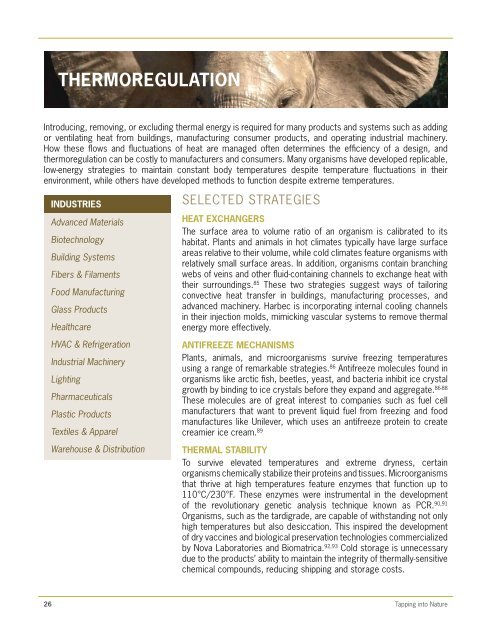Tapping-into-Nature-2015p
Tapping-into-Nature-2015p
Tapping-into-Nature-2015p
Create successful ePaper yourself
Turn your PDF publications into a flip-book with our unique Google optimized e-Paper software.
THERMOREGULATIONIntroducing, removing, or excluding thermal energy is required for many products and systems such as addingor ventilating heat from buildings, manufacturing consumer products, and operating industrial machinery.How these flows and fluctuations of heat are managed often determines the efficiency of a design, andthermoregulation can be costly to manufacturers and consumers. Many organisms have developed replicable,low-energy strategies to maintain constant body temperatures despite temperature fluctuations in theirenvironment, while others have developed methods to function despite extreme temperatures.INDUSTRIESAdvanced MaterialsBiotechnologyBuilding SystemsFibers & FilamentsFood ManufacturingGlass ProductsHealthcareSELECTED STRATEGIESHEAT EXCHANGERSThe surface area to volume ratio of an organism is calibrated to itshabitat. Plants and animals in hot climates typically have large surfaceareas relative to their volume, while cold climates feature organisms withrelatively small surface areas. In addition, organisms contain branchingwebs of veins and other fluid-containing channels to exchange heat withtheir surroundings. 85 These two strategies suggest ways of tailoringconvective heat transfer in buildings, manufacturing processes, andadvanced machinery. Harbec is incorporating internal cooling channelsin their injection molds, mimicking vascular systems to remove thermalenergy more effectively.HVAC & RefrigerationIndustrial MachineryLightingPharmaceuticalsPlastic ProductsTextiles & ApparelWarehouse & DistributionANTIFREEZE MECHANISMSPlants, animals, and microorganisms survive freezing temperaturesusing a range of remarkable strategies. 86 Antifreeze molecules found inorganisms like arctic fish, beetles, yeast, and bacteria inhibit ice crystalgrowth by binding to ice crystals before they expand and aggregate. 86-88These molecules are of great interest to companies such as fuel cellmanufacturers that want to prevent liquid fuel from freezing and foodmanufactures like Unilever, which uses an antifreeze protein to createcreamier ice cream. 89THERMAL STABILITYTo survive elevated temperatures and extreme dryness, certainorganisms chemically stabilize their proteins and tissues. Microorganismsthat thrive at high temperatures feature enzymes that function up to110°C/230°F. These enzymes were instrumental in the developmentof the revolutionary genetic analysis technique known as PCR. 90,91Organisms, such as the tardigrade, are capable of withstanding not onlyhigh temperatures but also desiccation. This inspired the developmentof dry vaccines and biological preservation technologies commercializedby Nova Laboratories and Biomatrica. 92,93 Cold storage is unnecessarydue to the products’ ability to maintain the integrity of thermally-sensitivechemical compounds, reducing shipping and storage costs.26<strong>Tapping</strong> <strong>into</strong> <strong>Nature</strong>


